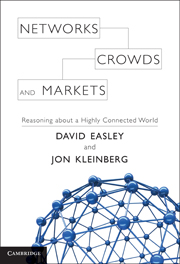Book contents
- Frontmatter
- Contents
- Preface
- 1 Overview
- Part I Graph Theory and Social Networks
- Part II Game Theory
- Part III Markets and Strategic Interaction in Networks
- Part IV Information Networks and the World Wide Web
- Part V Network Dynamics: Population Models
- Part VI Network Dynamics: Structural Models
- 19 Cascading Behavior in Networks
- 20 The Small-World Phenomenon
- 21s Epidemics
- Part VII Institutions and Aggregate Behavior
- Bibliography
- Index
21s - Epidemics
from Part VI - Network Dynamics: Structural Models
Published online by Cambridge University Press: 05 June 2012
- Frontmatter
- Contents
- Preface
- 1 Overview
- Part I Graph Theory and Social Networks
- Part II Game Theory
- Part III Markets and Strategic Interaction in Networks
- Part IV Information Networks and the World Wide Web
- Part V Network Dynamics: Population Models
- Part VI Network Dynamics: Structural Models
- 19 Cascading Behavior in Networks
- 20 The Small-World Phenomenon
- 21s Epidemics
- Part VII Institutions and Aggregate Behavior
- Bibliography
- Index
Summary
The study of epidemic disease has always been a topic that mixes biological issues with social ones. When we talk about epidemic disease, we will be thinking of contagious diseases caused by biological pathogens — things like influenza, measles, and sexually transmitted diseases — which spread from person to person. Epidemics can pass explosively through a population, or they can persist over long time periods at low levels; they can experience sudden flare-ups or even wavelike cyclic patterns of increasing and decreasing prevalence. In extreme cases, a single disease outbreak can have a significant effect on a whole civilization, as with the epidemics started by the arrival of Europeans in the Americas [130], or the outbreak of bubonic plague that killed 20% of the population of Europe over a seven-year period in the 1300s [293].
Diseases and the Networks That Transmit Them
The patterns by which epidemics spread through groups of people is determined not just by the properties of the pathogen carrying it — including its contagiousness, the length of its infectious period, and its severity — but also by network structures within the population it is affecting. The social network within a population — recording who knows whom — determines a lot about how the disease is likely to spread from one person to another. But more generally, the opportunities for a disease to spread are given by a contact network: there is a node for each person, and an edge if two people come into contact with each other in a way that makes it possible for the disease to spread from one to the other.
Information
- Type
- Chapter
- Information
- Networks, Crowds, and MarketsReasoning about a Highly Connected World, pp. 567 - 604Publisher: Cambridge University PressPrint publication year: 2010
Accessibility standard: Unknown
Why this information is here
This section outlines the accessibility features of this content - including support for screen readers, full keyboard navigation and high-contrast display options. This may not be relevant for you.Accessibility Information
- 1
- Cited by
